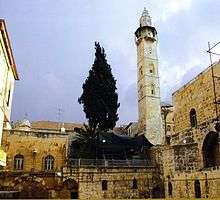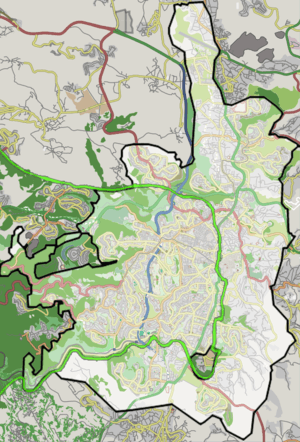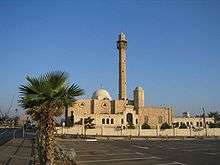Mosque of Omar (Jerusalem)
The Ayyubid Mosque of Omar (Arabic: مسجد عمر بن الخطاب, Hebrew: מסגד עומר) in Jerusalem is located opposite the southern courtyard of the Church of the Holy Sepulchre in the Muristan area of the Christian Quarter.
| Mosque of Omar | |
|---|---|
 Minaret of the Mosque next to the courtyard of the Church of the Holy Sepulchre | |
| Religion | |
| Affiliation | Islam |
| Location | |
| Location | Jerusalem |
 Shown within Jerusalem | |
| Territory | Christian Quarter of Old City of Jerusalem |
| Geographic coordinates | 31°46′40.21″N 35°13′46.52″E |
| Architecture | |
| Completed | 1193 |
| Specifications | |
| Minaret(s) | 1 |
| Minaret height | 15 metres |
The first (eastern) Mosque of Omar
According to later documents, after the Siege of Jerusalem in 637 by the Rashidun army under the command of Abu Ubaidah ibn al-Jarrah, Patriarch Sophronius refused to surrender except to the Caliph Omar (579-644) himself. Omar travelled to Jerusalem and accepted the surrender. He then visited the Church of the Resurrection (today better known as the Church of the Holy Sepulchre) where Sophronius invited him to pray inside the church, but Omar declined so as not to set a precedent and thereby endanger the church's status as a Christian site. Instead he prayed outside, on the steps east of the church.[1] The first Mosque of Omar was later built at that site, as evidenced by a stone plate with a Kufic inscription found in 1897 in the area of the eastern or outer atrium of the Constantinian (4th-century) Church of the Resurrection, defining this area as a mosque.[1]
The current (southern) Mosque of Omar
The current Mosque of Omar was built in its current shape by the Ayyubid Sultan Al-Afdal ibn Salah ad-Din in 1193 to commemorate the prayer of the caliph Omar.[2] The current mosque is located at a different site than the one where Omar is believed to have prayed and where the earlier mosque was located, since it stands to the south of the church rather than to the east of it. This new position is likely due to the fact that the entrance to the Church of the Holy Sepulchre had by then moved from the east to the south of the church, as a result of repeated destructive events that affected the Holy Sepulchre during the 11th and 12th centuries.[1]
The Ayyubid mosque has a 15 metres (49 ft) high minaret that was built sometime before 1465 during the Mamluk period, maybe after the 1458 earthquake,[3] and was renovated by Ottoman sultan Abdulmecid I (1839–1860).[4]
The two mosques flanking the Holy Sepulchre
The Al-Khanqah al-Salahiyya Mosque, located on the other (northern) side of the Church of the Holy Sepulchre, has an almost identical minaret,[2] erected in 1418.[5] The two minarets were obviously designed as a pair, and it is interesting to notice that a line connecting the two minarets would intersect the door of the Tomb of Jesus inside the church, while the minarets are equidistant to that door[5] and their tops reach exactly the same elevation, despite starting at different ground levels.[2]
Gallery
 In this 1915 map, the Mosque appears south of the Holy Sepulchre in Muristan, near the vertical middle of the map.
In this 1915 map, the Mosque appears south of the Holy Sepulchre in Muristan, near the vertical middle of the map. The Mosque has been reserved for religious activities
The Mosque has been reserved for religious activities Minaret
Minaret
References
- Krüger, Jürgen (2000). Die Grabeskirche zu Jerusalem : Geschichte, Gestalt, Bedeutung [The Church of the Holy Sepulchre in Jerusalem: History, Form, Importance] (in German). Regensburg: Schnell und Steiner. pp. 72–73. ISBN 3-7954-1273-0. Retrieved 29 May 2018.
- Murphy-O’Connor, Jerome (2008). The Holy Land: An Oxford Archaeological Guide from Earliest Times to 1700. Oxford Archaeological Guides. Oxford: Oxford University Press. pp. 62–63. ISBN 978-0-19-923666-4. Retrieved 20 June 2016.
- Murphy-O'Connor, Jerome (2008). "The City of Jerusalem. Two Mosques". The Holy Land: An Oxford Archaeological Guide from Earliest Times to 1700. Oxford Archaeological Guides. Oxford: Oxford University Press. p. 32. ISBN 978-0-19-923666-4. Retrieved 18 November 2017.
- Adamec, Ludwig W. (2017). Historical Dictionary of Islam. Rowman & Littlefield Publishers. p. 294. ISBN 978-1442277236.
- El Khanqah-Moschee in Jerusalem (German text and pictures at theologische-links.de)
Further reading
- Busse, Heribert, Die 'Umar-Moschee im östlichen Atrium der Grabeskirche (lit. "The Mosque of 'Umar in the eastern atrium of the Church of the Holy Sepulchre"), Zeitschrift des deutschen Palästina-Vereins, 109 (1993), pp. 73–82.
| Wikimedia Commons has media related to Mosque of Omar (Jerusalem). |


